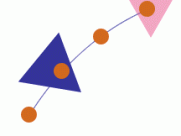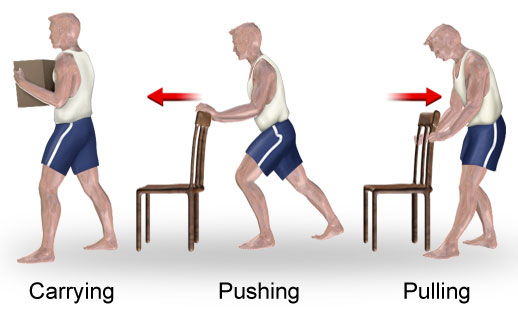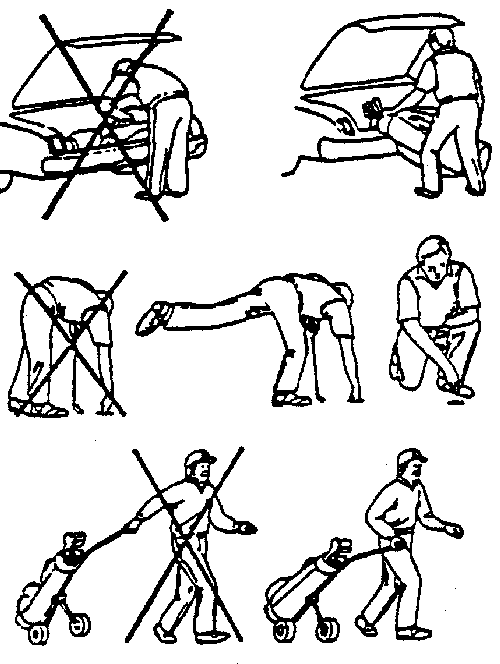Key Terms - Body Mechanics
"Body mechanics can be described as the use of one's body to produce motion that is safe, energy conserving, and anatomically and physiologically efficient and maintains body balance and control." - Pierson & Fairchild, Principles and Techniques of Patient Care, 5th Ed.
PTs and PTAs apply their knowledge of posture and how forces act on the body to teach and practice proper body mechanics. Why? Because PTs and PTA do a lot of lifting, stooping, carrying, bending, standing, kneeling, sitting, and squatting during patient care activities. Our patient's and clients are at risk for injury or reinjury during healing if everyday movements are not balanced and efficient. Repetitive microstrain leads to tissue failure, pain, loss of work, and risk for permanent disability. For a long, successful, and healthy career, we start with learning how to protect ourselves so that we can teach others how to recover from or prevent injury.
Body Mechanics Basics
For each situation, consider the effects of gravity (VGL) and friction when performing an optimal push, pull, lift, and carry.
Take home messages for body mechanics are succinctly stated in Procedure 4-1 of Pierson
- Vigilantly avoid breath holding while preparing to lift, push or pull. Breath holding while exerting effort is called a Valsalva Maneuver. Increased pressure in the thorax can significantly stress and/or injure the heart, large vessels, and intervertebral discs.
- The further the object is from the center of gravity (longer lever arms), the heavier it becomes. Heavy objects take more energy and strength to manipulate than lighter ones.
- When lifting an object, assess its center of gravity. Try lifting and holding from there so there are minimal rotation forces from gravity (see golf clubs in car above)
- Widen your base of support and position your legs in the direction of the motion when pushing/pulling. This will allow you increased stability while overcoming friction and gravitational forces.
- For standing activities that require rotation: lift feet and step to turn versus keeping feet planted while twisting. When the arms and legs go together, spine stress is minimized
- Locking the knees/elbows into full extension results in increase flexion forces in the spine (and interverterbral discs) and shoulders/neck respectively.
- When providing patient care at the bedside, take time to set up the treatment area to minimize your risk for injury: assess how much your patient can help, give clear directions, facilitate bringing the patient as close to you as possible to decrease torque to your spine during PT interventions.
- If there is equipment available to help lift and carry, USE IT. Examples are patient lifts, dollies, rolling carts, rolling casters (wheels) on hospital beds, foot pedals or manual cranks for adjusting bed/mat height, foot stools/step ladders, second or third person assist, etc. Prepare and be aware of your limitations and environmental constraints. Rush and take short cuts: someone (perhaps you?) is likely to get hurt.
Remember: gravity is POWERFUL. Do what you can to minimize the effects of gravity and you will minimize your risk for injury.
The 6 "L"s of Lifting
- LOAD - Always test the load. If it is too heavy, get help
- LEVER - Keep the load close to spine when in an upright position


- LORDOSIS - Maintain the low back in its anatomical position to protect discs, ligaments while lifting. Flexed spines put pressure on the posterior disc resulting in greater risk of herniation
- LEGS - Let your gluts, quad, and calf muscles do the heavy work. That's what they are made for!. Position legs for optimal base of support. Pick up your feet to turn...NO TWISTING. Make sure feet are free to move and change position so you can adjust your base of support as needed
- LUNG - Set abdominals and exhale as you lift. Breath holding can be dangerous!
- LOOK - Your head should lead the lift. Once you have a hold of the object, keep that head and chin up.
Common Lifting Mistakes
- Lifting with flexed spine and the legs straight
- Using a fast jerky movements
- Bending and twisting at the same time
- Poor planning
- Poor communication
- Insufficient strength
toc | return to top | previous page | next page



